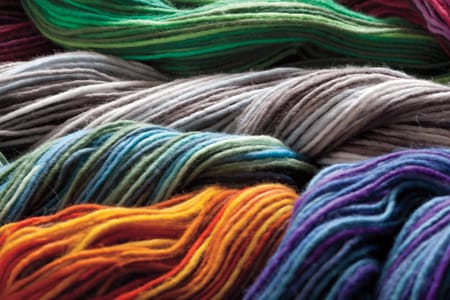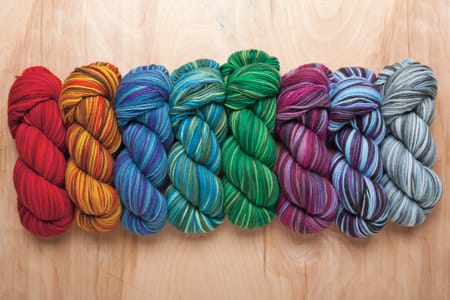Have you met the newest addition to our special reserve line up – Preciosa? This has got to be one of my favorite special reserve yarns to date, not only was I instantly drawn to the bright, saturated colors (I’m looking at you Ginger and Gecko!) but I have a special place in my world of fiber for single-ply yarns like Preciosa. My needles simply cannot resist the siren song of a single-ply Merino. And because Preciosa is a single-ply, the loose twist really brings out the cushiony softness of the fibers. Although single-ply yarns do require a bit of special attention, I’m always up for the extra care because the end result is just so lovely.
So let’s explore the world of single-ply yarns a bit more. In addition to weight, color and fiber content, one of the main defining characteristics of a yarn is its ply. This simply refers to the number of single strands that are twisted together to form one heavier strand of yarn. However, it is not always necessary to combine multiple singles together. Instead a single-ply yarn can stay in its simplest form and be enjoyed for its own unique properties, like our special reserve yarns Full Circle and Preciosa.
The look and feel of a single-ply yarn is smooth and when worked up, and Merino in particular tends to produce a fabric that is plush and blooms into a soft, relaxed fabric. And in my opinion, this is the perfect recipe for little luxuries like cowls (or maybe even a Mobius cowl, another obsession of mine!). Single-ply yarns, especially like Preciosa, work up into a particularly squish-able garter stitch fabric and are also wonderful for showcasing the fiber content of the yarn. Without the intertwining twists of additional strands that can change the look and feel of a fiber, single-ply yarns stay true to the nature of the fiber content – and it just might be the next best thing to petting an actual Merino sheep! However, it is this quality that gives single-ply yarns their lush feel, which can also work against your project if you’re not careful.
Since a single-ply yarn is essentially on its own, it can sometimes tend to be weaker than other yarns that are plied together. This is due to the low amount of twist that is required for a single-ply yarn to hold its fibers together (but remember, this the same quality that makes it so lovely and soft), but this also accounts for the fact that single-ply yarns tend to pill more. One quick solution to this quandary is to simply work the yarn up at a slightly tighter gauge.
As you work up a test swatch, use the recommended needle in addition to one or two smaller needle sizes. This way you can compare how the fabric works up when using the recommended size as well as a range of smaller needles to produce a tighter gauge. You will want to find a balance where the fabric feels firmer than with the recommended needle but not as stiff. A slightly tighter gauge along with the help of a lint shaver or pill remover will help battle any pilling caused by the yarn.
Given the nature of single-ply yarns, they work best when avoiding high-abrasion projects like socks, mittens, or gloves. The friction of normal wear and tear is concentrated onto one single strand of fiber, causing it to weaken and grow thin. By incorporating textured stitches, like ribbing and seed stitch, you will be able to add additional twists into your single-ply which will help to keep the fibers in place.
Knowing the properties of single-ply yarns and how you can make its unique qualities work for you will help you as you plan out your next project. Whether you opt for the earth-friendly fibers of Full Circle or simply want to indulge in the lavish softness of Preciosa, you’ll love the squishy qualities of single-ply yarns for warm and cozy sweaters, hats, scarves, and more!
Do you have any tips or tricks for working with single-ply yarn? I’d love to hear your suggestions.






